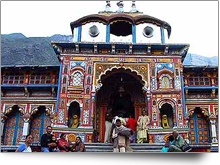
Badrinath is situated in the lap of Nar-Narayan Parvat, with the towering Neelkanth peak (6,597mts.) in the background. Also known as the Vishal Badri, the largest among the five Badris, it is revered by all as the apt tribute to Lord Vishnu.
It is believed that to revive the lost prestige of Hinduism and to unite the country in one bond, Adi Guru Sri Shankaracharya built four pilgrimage centres in four corners of India. Among them were Badrikashram (Badrinath temple) in the north,Rameshwaram in the south, Dwarkapuri in the west and Jagannath Puri in the east. Badrinath situated at an elevation of 3,133 mts. is considered to be amongst the most pious.
The revered spot was once carpeted with wild berries which gave it the name 'Badri Van' meaning 'forest of berries.' Built by Adi Shankaracharaya, the philosopher-saint of the 8th century, the temple has been renovated several times due to damage by avalanches and restored in the 19th century by the royal houses of Scindia & Holkar. The main entrance gate is colourful & imposing popularly known as Singhdwar.
Inside Badrinath Temple
A flight of steps takes pilgrims to the main gate & then into the Badrinath temple. The temple is divided into three parts - the 'Garbha Griha' or the sanctum sanctorum, the 'Darshan Mandap' where the rituals are conducted and the 'Sabha Mandap' where devotees assemble. The Garbha Griha portion has its canopy covered with a sheet of gold offered by Queen Ahilyabai Holkar. The complex has 15 idols especially attractive is the one-metre high image of lord Badrinath, finely sculpted in black stone. It represents Lord Vishnu seated in a meditative pose called padmasan.
Darshan Mandap: Lord Badrinath is sitting meditating in the padmasana (lotus yogic posture). As you look at the Deities, standing to the right side of Badrinarayana is Uddhava. To the far right side are Nara and Narayana. Narada Muni is kneeling in front on the right side and is difficult to see. On the left side are Kubera, the god of wealth, and a silver Ganesh. Garuda is kneeling in front, to the left of Badrinarayana.
Special pujas are also performed on behalf of individuals. Every puja must be preceded by a holy dip in the Tapta Kund. Some of the special morning pujas are Abhishek, Mahaabhishek, Geeta Path. Some special evening pujas are Aarti & Geet Govind. Such pujas are to be booked in advance. The Badrinath temple opens at 0430 hrs & closes at 1300 hrs. Once again it opens at 1600 hrs & closes at 2100 hrs after the divine song Geet Govind. Rawal is the administrator-Pujari of the temple well versed in puja ceremonials & Sanskrit language and is expected to be celibate..
Badri refers to a berry that was said to grow abundantly in the area, and nath refers to Vishnu. Badri is the Sanskrit name for the Indian Jujube trees, which has an edible berry. Some scriptural references also refer to Jujube trees being abundant inBadrinath. Legend has it that Goddess Lakshmi took the form of the berries to protect Lord Vishnu from the harsh climate during his long penance.
The opening date of Badrinath Temple is fixed on Basant Panchami by Raj Purohit and closure date is fixed on Vijaydashmi by Mandir Committee. The temple opens every year in the month of April-May & closes for winters in the third week of November.Joshimath is the winter deity of Badrinath.
Special booking of pujas can be done at Badrinath Mandir Committee by paying some fees. The pooja is organized before the temple is open for general public.
Some festivals celebrated in Badrinath are:
Mata Murti ka mela, Krishna Janamashtami and Badri-Kedar utsav.
Badrinath's four subsidiary Badris populary known as Panch Badri include Bhavishya Badri, Yogdhyan Badri, Bridha Badri andAdi Badri. It is popularly believed that with spread of Buddhism, the Buddhists enshrined the statue of Lord Buddha there and during the Hindu renaissance, the statue of Buddha was later restored by Adi Guru as the idol of Vishnu. This possibly explains the deity sitting in Padmasan posture, typical of Buddha icons. However, also according to Hindu mythology, Buddha was considered to be the ninth incarnation of Lord Vishnu.
Badrinath in Winters
Throughout the winter season, the ‘Utsav Murti' (idol used for public functions and to move around the temple) of Lord Badrinath is worshipped in Narasimha Temple at Joshimath. The idol is taken to the Narashimha Temple on a doli (palanquin) in a colorful procession. The priests of Badrinath Temple continue to perform the rituals on the ‘Utsav Murti’ at Narasimha temple during the winter season.
Best Season:
May to October every year the temple usually remains open from first week of May to 2nd week of November.
On the right bank of Alaknanda lies the sacred spot perched at an altitude of 3,133 meters above the sea level. Encircled by a beautiful valley, the 15 mts. high temple is dedicated to Lord Vishnu. It is built in the form of a cone with a small cup of a ilt bull and spire.
Built by adi guru Shankaracharya the philosopher-saint of the 8th century, the temple has been renovated several times due to damage by avalanches. Its colourful 'singh dwara' or the main entrance gate give it a new, modern look.
The temple is divided into three parts the 'garbha griha' or sanctum sanctorum, the 'darshan mandap' where the rituals are conducted and the 'sabha mandap' Where devotees assemble. The complex has 15 idols. Specially attractive is the one metre high image of Sri Badrinathji, finely sculpted in black stone. It represents lord Vishnu seated in a meditative
Devotees take a holy dip in the natural thermal springs on the banks of the river Alaknanda , before entering the Sri Badrinath ji Temple. The water of the Kund is believed to have medicinal properties.
